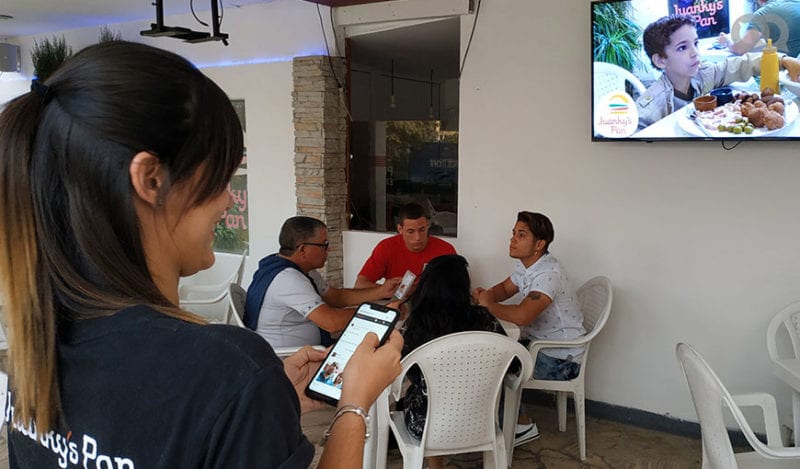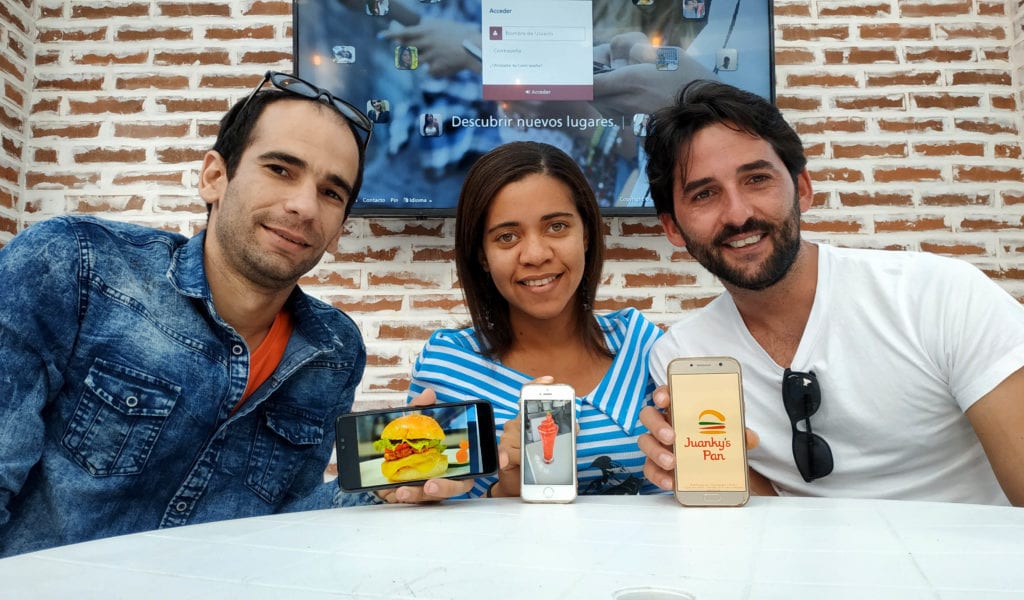Cuba: Businesses with Their Own E-menu & Social Media
By Sandra Madiedo (El Toque)

HAVANA TIMES – “Free WIFI?”, some people ask when entering Juanky’s Pan. “No!”, shop assistants reply. However, they then explain that Juanky’s Club has its own internal social network, which was created a year and a half ago so that users could socialize while going to a local business.
Gabriela Suarez had the same doubt when she went to the Havana cafe for the first time: “I was surprised to discover that in addition to enjoying a meal there, there was also WiFi and I could create a profile.”
The young woman registered and began surfing. She joined one of the existing groups and uploaded her photos while eating and sharing time with her friends.
“It was like signing into Facebook and I could do pretty much the same thing, just I wasn’t connected to the Internet. It’s one of the things I like the most about Juanky’s Pan, because I’m entertained and I’ve even met new people here,” she says.
In Cuban food service (one of the three largest self-employed sectors of business), some business owners have used technology as a competitive advantage to offer their customers a different experience.
They haven’t needed workers, and they don’t need robots to serve. However, businesses such as Arca de Noe, Juanky’s Pan and Dona Alicia have used technology to offer a more attractive service to customers, which goes beyond just food.
It works similiar to Facebook
Ever since the beginning, Reinaldo Cabrera Hernandez, Technology director, designed Juanky’s Club’s network as an extra; an entertaining and interactive space for customer feedback, available in different languages.
The interface and features are similar to those of Facebook. You can chat, share, post, have groups and check tags such as #clientefrecuente, which diners who appear in the top posts have to thank for discounts.
According to William Bello Sanchez, an expert in Business Management and business advisor for the CubaEmprende Project, technology makes these businesses more original and interesting. Interaction with these platforms can lock in young people’s loyalty and attraction, although it could be a limitation for another kind of audience.
In the case of Juanky’s Club, the interface “is very intuitive, people interact, promote their businesses, share photos which Tvs at these establishments automatically play so everyone can see,” Yoandra Rodriguez Betancourt says, Juanky’s Pan’s marketing director.
Reinaldo Cabrera adds that “this is possible thanks to the TV being a Smart TV, an online system, where every button has been configured to optimize processes. When it is a customer’s birthday, you just have to press a button and the Happy Birthday song plays.”
Sharing a similar experience, the pastry shop Arca de Noe also designed an internal social media network to “share cakes virtually”, says Yordan Alarcon, the business’ manager.
There, diners can create a personal account which allows them to not only access the menu, but also find out about the store’s history with images from before and and more recent ones too; recommend the establishment; leave comments and send messages.

In both cases, technology has been used to make service more efficient, to create greater interaction between visitors and the business, as it “really catches their attention, they sit down and can have a look at the menu,” Yordan Alarcon says.
According to Juan Carlos Blain Noste, the director of Juanky’s Pan, the main thing is “integrating them with what is going on. But, with mobile data nowadays, this poses a challenge for Juanky’s Club.”
“Our social media network has fulfilled and fulfills an objective, but Cubans are eager to sink their teeth into technology and are very anxious to do things. So, the challenge Juanky’s Club faces now is that customers still use it once they leave the cafe,” Reinaldo Cabrera says.
Expenses that become profit
In the eyes of these business owners, technology-related expenses are seen as a profitable investment because it creates many benefits: more loyal customers, dynamic services, eye-catching proposals and an abundance of valuable material such as data.
Via their social network, they have access to tastes, records of visits, contact information, content that can then be analyzed.
“It’s an essential marketing tool. It has been a mechanism to interrelate Juanky’s Club with Facebook, and Facebook with Juanky’s Club; always with the prerrogative of the user accepting the network’s terms and conditions, which gives us the right to use photos and content that is posted,” explains Yoandra Rodriguez.
These social media networks are another sales and communication channel, which users can use to express their opinions about the service provided. Reinaldo Cabrera explains that Juanky’s Pan’s idea isn’t to replace human contact because a screen can’t recommend a special dish. Technology is used as a means to create intimacy with visitors.
William Bello reinforces this when he says that “there are sales requirements that say that you end up buying something a lot of the time because of the person selling to you, the service you receive, and so you go back time and time again because you feel comfortable. However, ICT (Information and Communication Technology) doesn’t give you this comfort.”
Dona Alicia and her e-menu
While Juanky’s Pan and Arca de Noe opt for interaction, communication with sales assistants is basic at Dona Alicia’s. Here, the customer is the lead manager of their service, with touchscreens connected up to a network, which replace the traditional menu.
Nobody comes to your table to take your order and interaction is only necessary if there are any doubts, when dishes are served or to pay your bill in cash.
Dona Alicia is like Eatsa, people who have visited this fast food chain in the US would say, which provides an automated service.
This Cuban business has copied the model somewhat to offer a creole solution where paper and pens aren’t necessary, but when payments need to be made in cash and customers converse with restaurant staff.
They can choose drinks, desserts and main dishes using its user-friendly interface. Everything on the menu comes with a description and photo, and you can even read about the history of the business. The platform also has a timer which allows you to know how long your order will take. Plus, diners are given a total sum of their bill, every time they make a new order.

Dona Alicia offers a technological alternative to make up for shortcomings in face-to-face service, a phenomenon that affects all of Cuban society. This is one of the reasons that “many people prefer to engage with a machine rather than a person who won’t give them the service they expect,” William Bello says.
Caridad Camejo, a regular at this Havana restaurant, tells us that even though “waitors don’t always serve you properly, the digital order allows me to know how everything is going.”
An old business model such as food service is being transformed to maximize users’ experiences. Before signing off, you need to rate the service.
At Dona Alicia’s, they could get even more out of their idea if they wanted to. If customers were given the opportunity to log into any kind of network (such as Juanky Pan’s and Arca de Noe) tech-related profits would be even greater. With this data, they would be able to predict the days that visitors come; foresee their favorite dishes and drinks; estimate average bills or, even, enable visitors to tailor the menu to their own tastes.
Nevertheless, the owners of Dona Alicia know the general preferences of customers with this system, they just don’t know their names.
In a country that is becoming more and more connected and with greater access to information and communication technology, this business sector is also getting ready to improve, with their own social media networks and e-menus. Cuban businesses are exploiting new possibilities so they don’t get left behind and are gradually adapting to global-tested trends, but with a creole spin.






Great for Cuba, ?
Its a start for cuba but having travelef and stayed there a short time the goverment is not good to there people. I found everything to be expensive. Cubans have very limited food and when asked do u think socialism is working i say no.
I think the new rollout if cheap, fast cellular data will see more business innovations.
A friend of mine says one of her co-workers is hotspotting her phone and charging them to connect.
Cubans are very entrepreneurial . . .